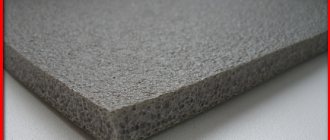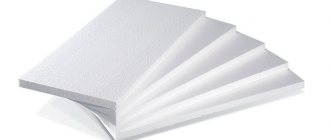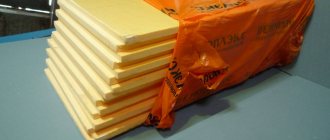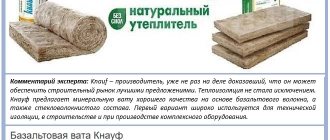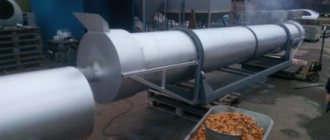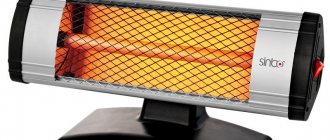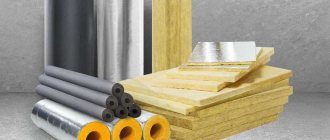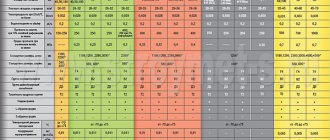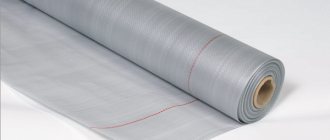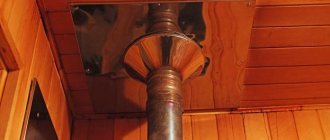What are NG materials?
What materials and substances are non-flammable? These are those that, when exposed to a source of ignition, are incapable of smoldering, igniting, spreading fire or charring.
Non-combustible panels for interior decoration
According to Art. 12 of the “Technical Regulations on Fire Safety Requirements”, which classifies materials according to fire hazard, GOST 12.1.044-89 about their fire and explosion hazard, the flammability group is a qualification characteristic for the combustion of substances of any origin, method of production of materials, in this case:
On this topic ▼
Fire triangle and fire tetrahedron
- Non-flammable/non-combustible materials and substances are those that are not capable of burning in the surrounding air.
- Some non-flammable substances that emit flammable vapors upon contact with each other, water, air O2, as well as strong oxidizing agents, are classified as fire and explosion hazards. Therefore, to establish the real inflammability of substances and materials obtained from them, the primary task is to determine their chemical composition and properties.
The laboratory and certification test results of materials and substances obtained during the assessment of the flammability group are used in the future for their classification, include data in GOST, technical production conditions; and are also used in determining the explosion and fire hazard category of protected objects and in developing fire prevention measures.
Flammability groups
All materials can be divided into three groups in accordance with Federal Law-123 standards:
1.
Non-flammable.
This group includes compounds that are not capable of burning in the presence of oxygen.
2.
Low-flammability.
Materials in this group ignite only when near an open flame or under the influence of strong, prolonged heat.
3.
Flammable.
In turn, they are divided into flammable and especially dangerous. Flammable are flammable substances and materials that ignite upon brief and short contact with fire.
This classification applies to all substances, with the exception of fabrics, leather and building materials. To determine the degree of flammability, tests are carried out regulated by fire safety standards.
Article 13 of Federal Law No. 123 provides for the classification of fabric materials and building compositions according to flammability groups:
1. Non-flammable
(symbol NG).
2. Low-flammable (G1).
When such substances ignite, gases with a temperature of no more than 135 ° C are released. Damage to the material itself as a result of combustion does not exceed 65%, while the mass decreases by no more than 20%. If the source of fire is removed, the material stops burning.
3. Moderately flammable (G2).
During combustion, the gas temperature is up to 235 ° C, damage affects 85% of the original volume. As a result of testing, the mass of the sample decreases by 50%. Once the flame source is removed, the moderately flammable substance can sustain combustion for up to 30 seconds.
4. Normally flammable (G3).
The flue gas temperature is up to 450 °C, the degree of damage and weight reduction are similar to group G2. In this case, the substance can maintain combustion in the absence of a fire source for up to 300 seconds.
5. Highly flammable (G4).
Such compositions emit gases with temperatures above 450 ° C when burned. The degree of damage exceeds 85% of the material area, the mass is reduced by more than 50%. The duration of combustion after the flame is removed is more than 300 seconds.
In addition to the degree of flammability, the characteristics of the substance also indicate its condition. For example, fuels and lubricants, flammable liquids and solid compounds, flammable and explosive gases are classified into separate groups.
Where are they used?
Most of these non-combustible materials are used in the construction of construction projects, for backfilling, improvement of adjacent land plots, and some substances are used as coolants and fire extinguishing agents.
The most important area of application of non-combustible materials is the construction of facilities, equipping them with external and internal utilities, because only their use in greater proportion with products made from flammable substances, for example, wood, can increase the fire resistance of buildings and structures, including those with an increased risk fires due to the characteristics of technological processes and fire load.
If recently the floors in multi-storey residential buildings and public buildings were made of wooden planks, now they have been replaced by cement-sand screeds covered with fire-resistant non-combustible linoleum, and the wall, ceiling, room partitions to level their surfaces are sheathed with fire-resistant fireproof cardboard on a gypsum basis .
Chimneys, stove pipes of residential buildings, baths are made mainly of solid brick, and fire-resistant cuts in places where they intersect floors and roofs of buildings are sealed and separated from combustible wood structures with fire-retardant mastics, pastes, and plasters.
For the construction of objects, piece building materials are most often used - brick, foam concrete blocks, reinforced concrete finished products; for external and internal finishing, insulation, both sheet and roll, bulk finishing, heat-insulating materials.
Considering the cold climate in most regions of our country, non-flammable fibrous heat insulators are in demand during the construction, repair of construction projects, and engineering communications of populated areas - from the usual mineral wool to fire-retardant basalt material, which are widely used for the following purposes, for:
- thermal insulation with rolled, semi-cylindrical foil elements of pipeline systems transporting water and its solutions, including water and foam fire extinguishing installations;
- insulation of ceilings of upper, technical floors; window doorways, floors, roofs;
- thermal insulation of attic floor structures;
- soundproofing of premises, buildings related to entertainment establishments, public catering establishments.
Thermal insulation of pipelines with non-combustible materials
The scope of application of various metals and their alloys is wide:
On this topic ▼
Fire safety during construction
- Steel - for the production of building load-bearing structures, as reinforcement for prefabricated reinforced concrete, monolithic structures of construction sites.
- Copper, aluminum - as cores of wires, cables, current-carrying elements of power supply systems.
- Cast iron, steel - for the manufacture of housings for industrial and engineering equipment, pipes of various diameters, shaped elements for their connection.
Although for some water supply systems, for example, water, foam fire extinguishing systems, and finely sprayed water extinguishing systems, it is acceptable to replace steel pipeline products with fire-resistant plastic pipes, but in general there is still no alternative to the use of non-flammable metal products.
Protecting the façade from fire
The choice of facade cladding for many homeowners depends entirely on aesthetic preferences - the cladding material largely determines the first impression of the building and provides ample opportunities for decorating the walls of the building with decorative elements. However, it would be more correct to choose construction products according to fire-technical parameters - many modern materials with polymer additives quickly ignite and are not able to contain the flame even for 20-30 minutes.
It is worth noting that external protection with cladding is needed for walls made of any material. Walls made of wood are the most vulnerable - any type of wood does not provide 100% fire protection even when impregnated with fire retardants. The construction of houses made of brick, aerated concrete or foam blocks guarantees fire resistance, however, both brick and concrete crack and can collapse under the influence of high temperatures during large-scale forest fires or burning of neighboring buildings.
Siding will help effectively protect the walls of a building from fire - a popular type of facade cladding that can be made from a variety of materials and perform not only a protective, but also an aesthetic function. In the 19th century in North America, siding made of overlapping wooden lining plates began to be used for the first time - simple finishing work made it possible to quickly give cottages a cozy and neat look and protect the wall material. Half a century later, other types of siding appeared in the USA and Canada - vinyl, metal and plinth. Let's look at the advantages and disadvantages of various types of siding.
- Wood siding is panels made from pressure-pressed wood chips held together with binders (resins and wear-retarding substances). Despite the additives, wood siding has average moisture resistance and can gradually become deformed from waterlogging. Since this type of cladding is created on the basis of wood shavings, its flammability is increased and does not allow high-quality protection of the walls of the house from fire;
- Steel siding - usually manufactured in the form of thin galvanized steel sheets with a polymer coating. Steel belongs to the group of non-flammable materials, does not emit toxins when heated and can withstand temperatures up to +800 C°, as well as exposure to water and aggressive fire extinguishing chemicals;
- Basement siding is a polymer product that belongs to the group of low-flammable building materials. Basement siding panels do not ignite as quickly as wooden ones and can hold the fire for a short time;
- Vinyl siding is made on the basis of PVC panels, which do not support combustion, but melt easily (flammability class G2) and are prohibited for use in fire-hazardous buildings. In hot regions (temperatures in summer from +30 C°), vinyl cladding may become deformed due to heating in the sun, and during winter frosts it may burst or crack.
Evaluating the presented selection of building materials, we can especially highlight non-flammable steel cladding - at the moment it is the optimally suitable, reliable and safe material for protecting the walls of a house from fire. In addition to high strength, the construction and finishing of houses using modern types of steel siding can make it possible to create a cottage with an original and attractive design: for example, Ecosteel polymer-coated steel cladding sheets on the Russian market imitate the surface of a brick wall and different types of wood.
Classification
Classification, according to GOST 30244-94 on fire test methods, is used when dividing all building materials into classes according to flammability groups:
- NG – non-flammable.
- G – flammable.
Non-combustible building materials are those that fully satisfy the following test conditions:
- The temperature increase in the oven is no more than 50%.
- Reduction in the mass of the tested material is no more than 50%.
- The period of stable combustion with an open flame is no more than 10 s.
The same materials used in construction, insulation, and finishing of objects that do not satisfy at least one indicator according to test results are classified as flammable.
There is also a classification of any construction projects according to the degree of fire resistance:
On this topic ▼
Determination of the fire resistance limit of building structures
- I – all elements are made of non-combustible materials, while the load-bearing elements of buildings and structures have a fire resistance limit of at least 2 hours.
- II - the same, but with a fire resistance limit of the load-bearing structure of 1.5 hours, while when creating roofless coverings of objects - trusses, beams, decks, it is allowed to use elements made of metal alloys that have not passed the fire protection of metal structures.
It is objects belonging to these two classes, completely made of non-combustible materials, substances used for their insulation, sound insulation, that are most resistant not only to fire inside them, but also to external abnormal influences - earthquakes, floods.
In addition, there is the following classification of non-combustible materials and substances used in the construction and repair of objects.
By purpose:
- Ready-made building structures, including various types of bricks and concrete blocks.
- Heat and sound insulating molded materials; bulk substances such as perlite, expanded clay.
- Decorative materials for finishing building premises, for example, marble, ceramic tiles.
According to the form of release of finished products:
- Structural elements - from reinforced concrete slabs, trusses to metal sandwich panels with non-flammable insulation.
- Sheet, roll, slab materials.
- Bulk substances.
Characteristics of materials and structures in terms of flammability and degree of explosion and fire hazard
Flammability —
the ability of a material subjected to local exposure to a high-temperature ignition source (pulse) to burn independently. All building materials and structures are divided into three groups according to the degree of flammability: non-combustible, non-combustible and combustible.
Fireproof to fire or high temperature, do not smolder or char.
Non-combustible structures are considered to be those made from non-combustible materials, as well as from combustible materials protected from fire by plaster or cladding made of non-combustible materials. Refractory materials, when exposed to fire or high temperature, are difficult to ignite, smolder or char. They continue to burn or smolder only in the presence of a fire source. These include materials consisting of fireproof (inorganic) and combustible (organic) substances: asbestobitumen materials, asphalt concrete, felt soaked in a clay solution, wood deeply impregnated with fire retardant compounds, etc.
Combustible structures include structures made from combustible materials (most organic materials that have not been deeply impregnated with fire retardants, such as wood, organic binders and other materials) that are not protected from high temperatures and fire. Combustible materials ignite or smolder when exposed to fire or heat and continue to burn or smolder after the source of ignition is removed.
Fire resistance of structural parts of buildings and structures is their ability to withstand design loads under the influence of high temperatures and other factors that arise in fire conditions.
The fire resistance of building structures in fire conditions is characterized by the fire resistance limit,
which is understood as the resistance of structures to fire:
- until they lose their bearing capacity and stability;
— until through cracks form;
- until the temperature on the unheated surface increases by an average of more than 140°C or at any point on this surface by more than 180°C compared to the average temperature of the structure before exposure to fire;
- until the temperature reaches 220°C and above, regardless of the initial temperature.
The fire resistance limit of structural elements is measured in hours, since it is determined by the period of time during which, under high-temperature test conditions, the structure loses its ability to perform its operating functions. For steel structures, it leaves 0.25-0.5 hours, since unprotected steel structures at high temperatures quickly deform and become inoperable. The fire resistance limit of columns, the reinforcement of which and the concrete work in compression, depends on the cross-section, thermal characteristics of the column material, the coefficient of change in the strength of concrete when exposed to high temperatures and the corresponding critical temperature.
The actual degree of fire resistance of buildings and structures is characterized by the flammability group and the minimum fire resistance limit of their parts. Based on fire resistance, buildings and structures are divided into five degrees (I - V).
The category of a room in terms of explosion and fire hazard (Table 9.1) is determined by sequentially excluding its belonging to categories from the highest (A) to the lowest (D). To do this, it is necessary to establish, using a reference book, the fire hazardous properties of substances, mixtures and technical products available in the room or that may enter it at the time of the accident, select the most unfavorable version of the accident, find the mass of flammable substances that will be in the room at the time of the accident, and calculate the value excess explosion pressure.
Classification of buildings by explosion and fire hazard is based on the classification of premises. A building belongs to category A if its total area of category A premises exceeds 5 %
area of all premises or 200 m2. It is allowed not to classify a building as category A if the total area of category A premises in the building does not exceed 25% of the total area of all its premises (but not more than 1,000 m2) and these premises are equipped with automatic fire extinguishing installations.
The building belongs to category B ,
if two conditions are simultaneously met: the building does not belong to category A; the total area of premises of categories A and B exceeds 5% of the total area of all premises or 200 m2. It is allowed not to classify a building as category B if the total area of premises of categories A and B in the building does not exceed 25% of the total area of all its premises (but not more than 1,000 m2) and these premises are equipped with automatic fire extinguishing installations.
The building belongs to category B ,
if two conditions are simultaneously met: the building does not belong to category A or B;
the total area of premises of categories A, B and C exceeds 5 %
(10% if the building does not have premises of categories A and B) of the total area of all premises. It is allowed not to classify a building as category B if the total area of premises of categories A, B, C in the building does not exceed 25% of the total area of all its premises (but not more than 3,500 m2) and these premises are equipped with automatic fire extinguishing installations.
Table 9.1.
Categories of premises according to explosion and fire hazard
| Room category | Characteristics of substances and materials located (circulating) in the premises |
| A Explosive | Combustible gases, flammable liquids with a flash point of no more than 28°C in such quantities that they can form explosive vapor-gas mixtures, upon ignition of which a calculated excess explosion pressure in the room develops exceeding 5 kPa. Substances and materials capable of exploding and burning when interacting with water, air oxygen or with each other in such quantities that the calculated excess explosion pressure in the room exceeds 5 kPa |
| B Explosion-fire-hazardous | Combustible dusts or fibers, flammable liquids with a flash point of more than 28°C, flammable liquids in such quantities that they can form explosive dust-air or steam-air mixtures, the ignition of which develops a calculated excess explosion pressure in the room exceeding 5 kPa |
| In Fire Hazardous | Flammable and low-flammable liquids, solid flammable and low-flammable substances and materials (including dust and fibers), substances and materials that can only burn when interacting with water, atmospheric oxygen or with each other, provided that the rooms in which they are present are in available or in circulation, do not belong to categories A or B |
| G | Non-combustible substances and materials in a hot, incandescent or molten state, the processing of which is accompanied by the release of radiant heat, sparks and flames; flammable gases, liquids and solids that are burned or disposed of as fuel |
| D | Non-combustible substances and materials in a cold state |
The building belongs to category G ,
if two conditions are simultaneously met: the building does not belong to categories A, B and C; the total area of premises of categories A, B, C and D exceeds 5% of the total area of all premises. It is allowed not to classify a building as category D if the total area of premises of categories A, B, C and D in the building does not exceed 25% of the total area of all premises located in it (but not more than 5,000 m2), and premises of categories A, B, C equipped with automatic fire extinguishing installations.
The building belongs to category D ,
unless it falls into categories A, B, C and D.
The categories of premises and buildings defined in accordance with SNiP 21-01-97 “Fire safety of buildings and structures” should be used to establish regulatory requirements for ensuring explosion and fire safety of premises and buildings, including when planning areas and placing equipment.
The main criterion for dividing production according to the degree of fire danger is the physical and chemical properties of the substances used in the production process. In accordance with fire safety standards, all production is divided into five categories according to the degree of fire danger.
Category A -
production related to the production, use or storage of gases and vapors with a lower explosive limit (the minimum concentration of a substance in the air at which an explosion is possible) of up to 10%, contained in such quantities that the formation of explosive mixtures with air is possible; liquids with a vapor flash point of 28°C below; solids and liquids that may ignite or explode when interacting with water or atmospheric oxygen.
Category B -
production related to the processing, use, formation or storage of gases and vapors with a lower explosive limit of more than 10%, contained in quantities sufficient to form explosive mixtures; liquids with a vapor flash point of 28-120°C; flammable substances that emit dust or fibers in quantities sufficient to form explosive mixtures with air.
Category B -
production that uses liquids with a vapor flash point above 120°C or processes solid combustible substances.
Category G -
production associated with the processing of non-combustible substances and materials in a hot, hot or molten state with the release of radiant energy, sparks, flames, as well as production associated with the combustion of solid, liquid and gaseous fuels.
Category D -
production facilities that store or process non-combustible substances and materials in a cold state.
Kinds
Based on their state of aggregation, there are three types of non-combustible substances, both natural and artificial.
Solid, which can be in the form of building structures, heat-insulating, sound-insulating, finishing materials, bulk substances:
On this topic ▼
Means and methods of fire protection
- Mountain rocks - granite, diabase, marble, diorite, flint, gneiss, dolomite; as well as softer sandstones and limestones.
- Gravel, crushed stone, screenings, sand.
- Chalk, cement, clay.
- Asbestos, gypsum, lime, mortars, plasters.
- Concrete, reinforced concrete products.
- Cast iron, various types of rolled steel - from large I-beams, channels to sheets.
- Copper, brass, bronze, aluminum.
- Various types of glass products, including fire-resistant glass.
- Textile materials – fire-resistant non-flammable fabric, basalt rolled materials.
- Various types of mineral wool.
Non-flammable mineral wool mats
Liquid:
- Water used for drinking, watering plants, and also as a coolant in heat supply systems, a fire extinguishing agent in external and internal fire extinguishing networks.
- Aqueous solutions of salts, acids, alkalis.
- Solutions of detergents, foaming agents.
- Non-flammable synthetic fluids.
Gaseous:
- Nitrogen.
- Carbon dioxide.
- Argon.
- Refrigerants.
Requirements
They are set out in many regulatory documents regulating fire hazards, fire resistance of building structures, and materials made from non-combustible materials. Among them:
- GOST 30244-94 – on regulations for testing the flammability of building materials, classification by flammability groups. The standard does not apply to paint and varnish products, as well as other building materials produced in solutions, powders, and granules.
- NPB 244-97 – on the fire hazard indicators of facing, decorative and finishing, roofing, heat and waterproofing materials, floor coverings.
- GOST 4640-2011 – on technical conditions for the production of mineral wool from melts of rocks, sedimentary rocks, volcanic, metallurgical slags, silicate wastes, intended for the production of heat and sound insulating building materials. The resulting commercial wool is used in construction, as well as for thermal insulation of the surfaces of industrial equipment and pipelines with temperatures ranging from – 180 to 700 ºC.
- GOST 21880-2011 – on technical conditions for the production of pierced thermal insulation mats made of mineral wool, intended for thermal insulation of the enclosing structure of construction projects, water storage tanks, hydrocarbon raw materials, and petroleum products; water supply systems, industrial pipelines.
- GOST 32313-2011 – on rigid, semi-rigid slabs, mats, including those reinforced with metal mesh, foil, cylinders, and other industrial mineral wool products used for insulating utility lines of construction sites, technological installations operating at temperatures from 0 to 1000 ºC.
- GOST 32314-2012 – about products made from various types of mineral wool used in construction.
- GOST 32603-2012 – on specifications for the production of metal panels with mineral wool insulation, used as enclosing structures during the construction of civil and industrial construction projects.
In addition to fire resistance, for non-combustible materials and substances, the standards also put forward other technical requirements for:
- bending strength, tensile strength;
- moisture resistance;
- hygroscopicity;
- density;
- specific viscosity;
- thermal conductivity;
- deformation changes when heated, wet.
Many non-flammable materials and substances are used not only in construction, finishing work, equipping facilities with utility networks, but also in the production of fire extinguishers, stationary fire extinguishing systems, smoke protection, therefore the requirements for them in each specific case are regulated by the relevant sets of rules and standards.
